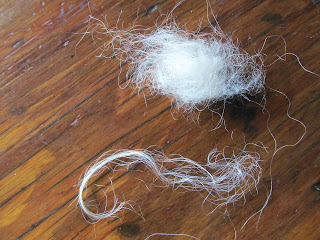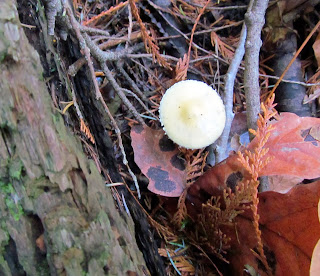After having such good luck with
my recent mushroom adventure, I've started noticing more members of the fungal world... that can't be the right name for it... anyway, went for a lichen gathering trip to the woods today with my camera in tow. Took lots of photos of mushrooms. Since I don't eat mushrooms, I don't have to worry about which ones are edible or not. Besides, I only know of one variety that is for sure, well probably for sure, well, mostly for sure, not poison...or at least, not going to send you to hospital then the morgue. But I'm told it doesn't taste very good, so I'm not going to bother trying it.
Starting off, a patch of what I'm calling oyster mushrooms. I'm guessing that's what they might be because our neighbour use to have one of the largest oyster mushroom farms around, and I'm sure some of the mushrooms may have escaped into the wild.
These 'oyster' mushrooms are really soft to the touch, almost frictionless. Mushrooms are weird but increasingly pretty.
Speaking of pretty, I spotted something nice.
Fairly certain it's the same kind as
I found on the ground earlier. The stump is an old Douglas Fir (for you city folk don't cry about the tree. It's a woodlot, people cut down trees, that's where the stumps come from. It's proper management of the forest which is key, and includes removing some trees each year. Without removing some trees and leaving detritus like stumps and branches in the forest to rot, we wouldn't have nice things like this for the mushrooms to grow on.).
My lay person name for this mushroom is going to be Brown Douglass Bracket Fungus. Not the correct name, but it's a starting place and allows me to tell it apart from the brown and white fungus of a similar shape that grows on the Big Leaf Maples. I have a real slow brain for learning latin names, so when I start learning about fungus, I'll make a little picture dictionary for myself with proper botanical names, common names, and my creative names.
um, well, anyway... it's large. Hand is here so you can get an idea of how big it is.
Now I know this makes colour, and a nice colour at that, the next thing to learn is how to harvest it without doing harm. It's a really small ecosystem, only about 5 acres, and most of my neighbour's forests are stripped of native species, so I don't want to do any unnecessary harm. Worse comes to worse, I will stick to salvage botany (picking up plants and stuff that fell down on their own) and leave the mushroom alone to do whatever it is that mushrooms do best.
More random mushrooms that were photogenic.
And another patch of these oyster mushrooms (which are probably not oyster mushrooms at all, but they are nifty to look at).
Random mushroom on a stump
And an even larger Brown Douglass Bracket Fungus.
It looks lighter than the other, at least in the photo, but they were the same colour. It just shows differently in different lights. Though I was a bit surprised to find this one on the south side of the stump in direct sunlight. The other ones like the East or North side best. This is growing on a Douglas Fir stump as well, hand in picture to help you get an idea of size.
And here we have Witches Butter. The only wild mushroom I know for certain. Doesn't look like much of a mushroom to me, but I'm a fan of the bright colour.
Apparently we can eat Witches Butter, at least I think we can. But check with an expert source that is relevant to your location before popping wild mushrooms in your mouth.
And yes, another mushroom.
In the fall we get a lot of fluorescent coloured mushrooms, and yellow frilly ones which may be chanterelles. But this time of year, we get mostly subdued colours. There should be more in the forest by now, but we haven't had any rain for a while.
 I was blessed with the chance to play with Ashford's new fibre that is coming out soon. It's a blend of 30% alpaca and 70% marino, and it's fantastic.
I was blessed with the chance to play with Ashford's new fibre that is coming out soon. It's a blend of 30% alpaca and 70% marino, and it's fantastic.
















































